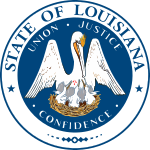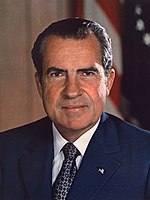| ||||||||||||||||||||||||||
| ||||||||||||||||||||||||||
 Parish Results
| ||||||||||||||||||||||||||
| ||||||||||||||||||||||||||
| Elections in Louisiana |
|---|
 |
|
|
The 1972 United States presidential election in Louisiana took place on November 7, 1972. All 50 states and the District of Columbia were part of the 1972 United States presidential election. State voters chose ten electors to the Electoral College, who voted for president and vice president.
Louisiana was won by the Republican nominees, incumbent President Richard Nixon of California and his running mate Vice President Spiro Agnew of Maryland. Nixon and Agnew defeated the Democratic nominees, Senator George McGovern of South Dakota and his running mate U.S. Ambassador Sargent Shriver of Maryland.
Nixon carried Louisiana with 65.32% of the vote to McGovern's 28.35%, a victory margin of 36.97%, making Louisiana 13.8% more Republican than the nation-at-large, and marking the strongest Republican presidential performance in Louisiana history. In a result that would reflect McGovern's national performance, the Democratic candidate only won one parish (West Feliciana) in Louisiana. As of the 2020 presidential election[update], this is the last election when Iberville Parish, Madison Parish, St. James Parish, St. Helena Parish, East Carroll Parish, and the city of New Orleans (coterminous with Orleans Parish) have voted for a Republican presidential candidate.[1] With 4.95 percent of the popular vote, Louisiana would prove to be American Party candidate John G. Schmitz’ fifth strongest state after Idaho, Alaska, Utah and Oregon.[2]
With 4.95 percent of the popular vote, Louisiana would prove to be American Party candidate John G. Schmitz’ fifth strongest state after Idaho, Alaska, Utahand Oregon.[3]
- ^ Sullivan, Robert David; ‘How the Red and Blue Map Evolved Over the Past Century’; America Magazine in The National Catholic Review; June 29, 2016
- ^ "1972 Presidential Election Statistics". Dave Leip’s Atlas of U.S. Presidential Elections. Retrieved March 5, 2018.
- ^ "1972 Presidential Election Statistics". Dave Leip’s Atlas of U.S. Presidential Elections. Retrieved March 5, 2018.
© MMXXIII Rich X Search. We shall prevail. All rights reserved. Rich X Search


